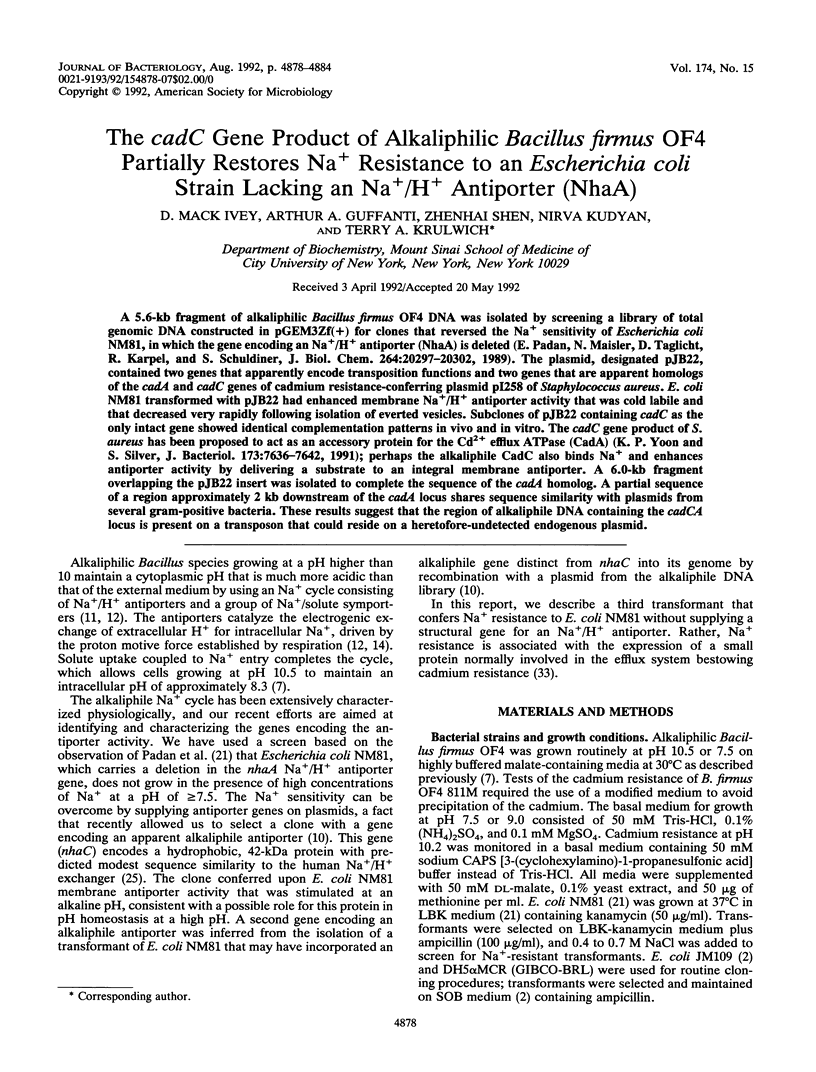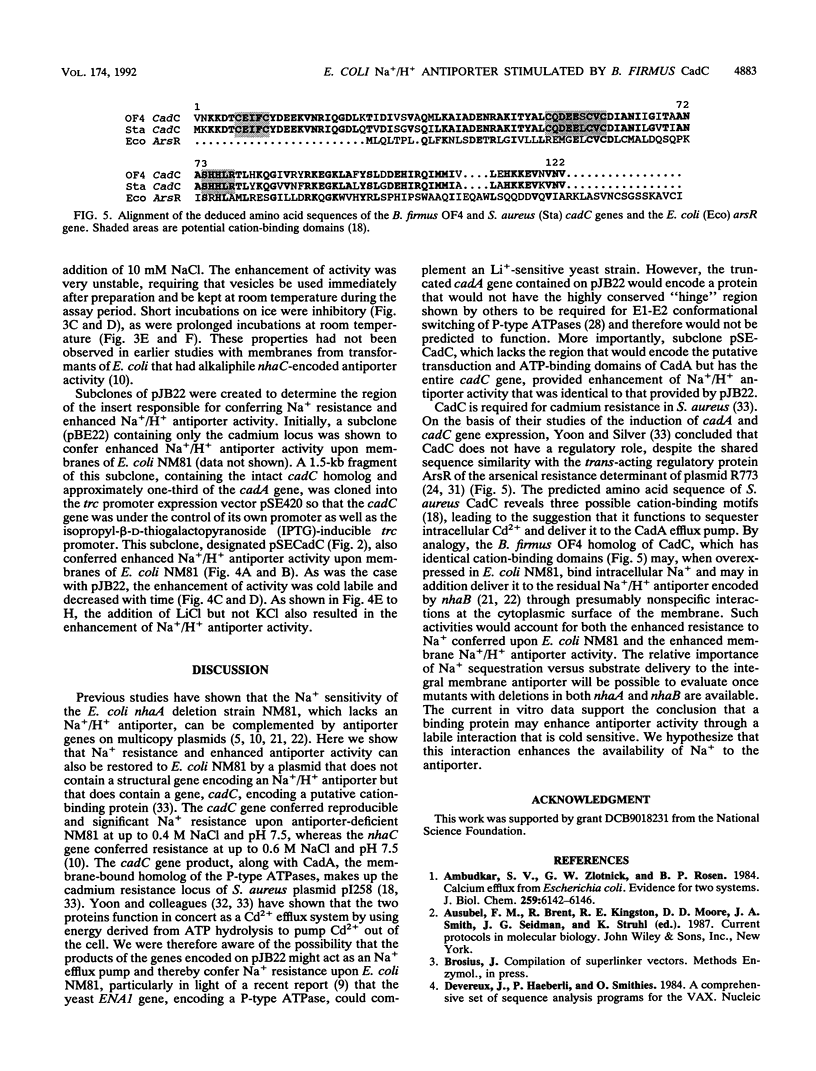Abstract
A 5.6-kb fragment of alkaliphilic Bacillus firmus OF4 DNA was isolated by screening a library of total genomic DNA constructed in pGEM3Zf(+) for clones that reversed the Na+ sensitivity of Escherichia coli NM81, in which the gene encoding an Na+/H+ antiporter (NhaA) is deleted (E. Padan, N. Maisler, D. Taglicht, R. Karpel, and S. Schuldiner, J. Biol. Chem. 264:20297-20302, 1989). The plasmid, designated pJB22, contained two genes that apparently encode transposition functions and two genes that are apparent homologs of the cadA and cadC genes of cadmium resistance-conferring plasmid pI258 of Staphylococcus aureus. E. coli NM81 transformed with pJB22 had enhanced membrane Na+/H+ antiporter activity that was cold labile and that decreased very rapidly following isolation of everted vesicles. Subclones of pJB22 containing cadC as the only intact gene showed identical complementation patterns in vivo and in vitro. The cadC gene product of S. aureus has been proposed to act as an accessory protein for the Cd2+ efflux ATPase (CadA) (K. P. Yoon and S. Silver, J. Bacteriol. 173:7636-7642, 1991); perhaps the alkaliphile CadC also binds Na+ and enhances antiporter activity by delivering a substrate to an integral membrane antiporter. A 6.0-kb fragment overlapping the pJB22 insert was isolated to complete the sequence of the cadA homolog. A partial sequence of a region approximately 2 kb downstream of the cadA locus shares sequence similarity with plasmids from several gram-positive bacteria. These results suggest that the region of alkaliphile DNA containing the cadCA locus is present on a transposon that could reside on a heretofore-undetected endogenous plasmid.
Full text
PDF






Images in this article
Selected References
These references are in PubMed. This may not be the complete list of references from this article.
- Ambudkar S. V., Zlotnick G. W., Rosen B. P. Calcium efflux from Escherichia coli. Evidence for two systems. J Biol Chem. 1984 May 25;259(10):6142–6146. [PubMed] [Google Scholar]
- Goldberg E. B., Arbel T., Chen J., Karpel R., Mackie G. A., Schuldiner S., Padan E. Characterization of a Na+/H+ antiporter gene of Escherichia coli. Proc Natl Acad Sci U S A. 1987 May;84(9):2615–2619. doi: 10.1073/pnas.84.9.2615. [DOI] [PMC free article] [PubMed] [Google Scholar]
- Guffanti A. A., Hicks D. B. Molar growth yields and bioenergetic parameters of extremely alkaliphilic Bacillus species in batch cultures, and growth in a chemostat at pH 10.5. J Gen Microbiol. 1991 Oct;137(10):2375–2379. doi: 10.1099/00221287-137-10-2375. [DOI] [PubMed] [Google Scholar]
- Guffanti A. A., Quirk P. G., Krulwich T. A. Transfer of Tn925 and plasmids between Bacillus subtilis and alkaliphilic Bacillus firmus OF4 during Tn925-mediated conjugation. J Bacteriol. 1991 Mar;173(5):1686–1689. doi: 10.1128/jb.173.5.1686-1689.1991. [DOI] [PMC free article] [PubMed] [Google Scholar]
- Haro R., Garciadeblas B., Rodríguez-Navarro A. A novel P-type ATPase from yeast involved in sodium transport. FEBS Lett. 1991 Oct 21;291(2):189–191. doi: 10.1016/0014-5793(91)81280-l. [DOI] [PubMed] [Google Scholar]
- Ivey D. M., Guffanti A. A., Bossewitch J. S., Padan E., Krulwich T. A. Molecular cloning and sequencing of a gene from alkaliphilic Bacillus firmus OF4 that functionally complements an Escherichia coli strain carrying a deletion in the nhaA Na+/H+ antiporter gene. J Biol Chem. 1991 Dec 5;266(34):23483–23489. [PubMed] [Google Scholar]
- Krulwich T. A., Guffanti A. A. Alkalophilic bacteria. Annu Rev Microbiol. 1989;43:435–463. doi: 10.1146/annurev.mi.43.100189.002251. [DOI] [PubMed] [Google Scholar]
- Krulwich T. A., Guffanti A. A., Fong M. Y., Falk L., Hicks D. B. Alkalophilic Bacillus firmus RAB generates variants which can grow at lower Na+ concentrations than the parental strain. J Bacteriol. 1986 Mar;165(3):884–889. doi: 10.1128/jb.165.3.884-889.1986. [DOI] [PMC free article] [PubMed] [Google Scholar]
- Krulwich T. A., Guffanti A. A., Seto-Young D. pH homeostasis and bioenergetic work in alkalophiles. FEMS Microbiol Rev. 1990 Jun;6(2-3):271–278. doi: 10.1111/j.1574-6968.1990.tb04100.x. [DOI] [PubMed] [Google Scholar]
- Krulwich T. A., Guffanti A. A. The Na+ cycle of extreme alkalophiles: a secondary Na+/H+ antiporter and Na+/solute symporters. J Bioenerg Biomembr. 1989 Dec;21(6):663–677. doi: 10.1007/BF00762685. [DOI] [PubMed] [Google Scholar]
- LOWRY O. H., ROSEBROUGH N. J., FARR A. L., RANDALL R. J. Protein measurement with the Folin phenol reagent. J Biol Chem. 1951 Nov;193(1):265–275. [PubMed] [Google Scholar]
- Mahillon J., Lereclus D. Structural and functional analysis of Tn4430: identification of an integrase-like protein involved in the co-integrate-resolution process. EMBO J. 1988 May;7(5):1515–1526. doi: 10.1002/j.1460-2075.1988.tb02971.x. [DOI] [PMC free article] [PubMed] [Google Scholar]
- Nies D. H. Resistance to cadmium, cobalt, zinc, and nickel in microbes. Plasmid. 1992 Jan;27(1):17–28. doi: 10.1016/0147-619x(92)90003-s. [DOI] [PubMed] [Google Scholar]
- Novick R. P., Roth C. Plasmid-linked resistance to inorganic salts in Staphylococcus aureus. J Bacteriol. 1968 Apr;95(4):1335–1342. doi: 10.1128/jb.95.4.1335-1342.1968. [DOI] [PMC free article] [PubMed] [Google Scholar]
- Nucifora G., Chu L., Misra T. K., Silver S. Cadmium resistance from Staphylococcus aureus plasmid pI258 cadA gene results from a cadmium-efflux ATPase. Proc Natl Acad Sci U S A. 1989 May;86(10):3544–3548. doi: 10.1073/pnas.86.10.3544. [DOI] [PMC free article] [PubMed] [Google Scholar]
- Padan E., Maisler N., Taglicht D., Karpel R., Schuldiner S. Deletion of ant in Escherichia coli reveals its function in adaptation to high salinity and an alternative Na+/H+ antiporter system(s). J Biol Chem. 1989 Dec 5;264(34):20297–20302. [PubMed] [Google Scholar]
- Pinner E., Padan E., Schuldiner S. Cloning, sequencing, and expression of the nhaB gene, encoding a Na+/H+ antiporter in Escherichia coli. J Biol Chem. 1992 Jun 5;267(16):11064–11068. [PubMed] [Google Scholar]
- Rosen B. P. Ion extrusion systems in Escherichia coli. Methods Enzymol. 1986;125:328–336. doi: 10.1016/s0076-6879(86)25028-4. [DOI] [PubMed] [Google Scholar]
- San Francisco M. J., Hope C. L., Owolabi J. B., Tisa L. S., Rosen B. P. Identification of the metalloregulatory element of the plasmid-encoded arsenical resistance operon. Nucleic Acids Res. 1990 Feb 11;18(3):619–624. doi: 10.1093/nar/18.3.619. [DOI] [PMC free article] [PubMed] [Google Scholar]
- Sardet C., Franchi A., Pouysségur J. Molecular cloning, primary structure, and expression of the human growth factor-activatable Na+/H+ antiporter. Cell. 1989 Jan 27;56(2):271–280. doi: 10.1016/0092-8674(89)90901-x. [DOI] [PubMed] [Google Scholar]
- Shaw J. H., Clewell D. B. Complete nucleotide sequence of macrolide-lincosamide-streptogramin B-resistance transposon Tn917 in Streptococcus faecalis. J Bacteriol. 1985 Nov;164(2):782–796. doi: 10.1128/jb.164.2.782-796.1985. [DOI] [PMC free article] [PubMed] [Google Scholar]
- Silver S., Nucifora G., Chu L., Misra T. K. Bacterial resistance ATPases: primary pumps for exporting toxic cations and anions. Trends Biochem Sci. 1989 Feb;14(2):76–80. doi: 10.1016/0968-0004(89)90048-0. [DOI] [PubMed] [Google Scholar]
- Silver S. Plasmid-determined metal resistance mechanisms: range and overview. Plasmid. 1992 Jan;27(1):1–3. doi: 10.1016/0147-619x(92)90001-q. [DOI] [PubMed] [Google Scholar]
- Silver S., Walderhaug M. Gene regulation of plasmid- and chromosome-determined inorganic ion transport in bacteria. Microbiol Rev. 1992 Mar;56(1):195–228. doi: 10.1128/mr.56.1.195-228.1992. [DOI] [PMC free article] [PubMed] [Google Scholar]
- Smith K., Novick R. P. Genetic studies on plasmid-linked cadmium resistance in Staphylococcus aureus. J Bacteriol. 1972 Nov;112(2):761–772. doi: 10.1128/jb.112.2.761-772.1972. [DOI] [PMC free article] [PubMed] [Google Scholar]
- Wu J., Rosen B. P. The ArsR protein is a trans-acting regulatory protein. Mol Microbiol. 1991 Jun;5(6):1331–1336. doi: 10.1111/j.1365-2958.1991.tb00779.x. [DOI] [PubMed] [Google Scholar]
- Yoon K. P., Misra T. K., Silver S. Regulation of the cadA cadmium resistance determinant of Staphylococcus aureus plasmid pI258. J Bacteriol. 1991 Dec;173(23):7643–7649. doi: 10.1128/jb.173.23.7643-7649.1991. [DOI] [PMC free article] [PubMed] [Google Scholar]
- Yoon K. P., Silver S. A second gene in the Staphylococcus aureus cadA cadmium resistance determinant of plasmid pI258. J Bacteriol. 1991 Dec;173(23):7636–7642. doi: 10.1128/jb.173.23.7636-7642.1991. [DOI] [PMC free article] [PubMed] [Google Scholar]



